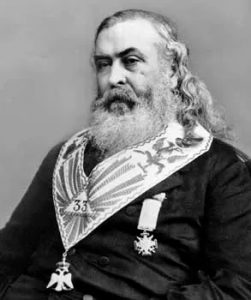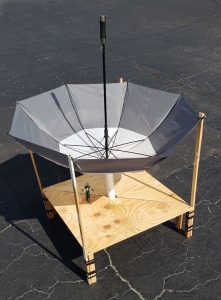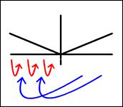A Reexamination of Climate Change Issues
Issues with the ”Hockey Stick Curve”
updated October 13, 2022

The “Hockey Stick Curve”
Up until 1995, most climate scientists had a common view of the temperatures of the Earth’s climate over the past millennium to include periods being as warm or warmer than they are now, as well as periods which have been much colder. Scientific evidence and historical records show events such as a “Medieval Warm Period” between 700 - 1300 AD, and a “Little Ice Age” between 1560 - 1830 AD, which demonstrate wide temperature variability occuring in the climate without man’s contribution of greenhouse gasses.
Currently the severity and global scope of the extremes of the past millennium’s warming and cooling are debated, especially in light of a recently published graph known as the “hockey stick curve,” which flattens previously accepted past high and low temperature periods, resulting in making current warming appear to be exceptional. This article explores many issues concerning the accuracy of the “hockey stick curve.”
Jump to sections of this page ..
Graphical Summary of the “Hockey Stick” Issue
[Macro error: Can't compile this script because of a syntax error.]

Fig. 2 — A graph of the original “hockey stick curve” as released in 1999, which was used to kick off a tremendous wave of global warming hysteria. Note the extreme recent temperatures and the disappearance of the Medieval Warm Period and Little Ice Age from the graph. It has since been shown that the graph was a result of sampling methods and software which would always bias for a hockey stick shape.

Fig. 3 — A graph of a recently published “hockey stick curve,” in the 2008 proceedings of the National Academy of Sciences.
Issues with “The Hockey Stick Curve" — From “Global Warming or Global Governance?”
This video clip explains inaccuracies with one of the most recently accepted methodologies for describing temperature variations over the past thousand years, known as the “Hockey Stick Curve,” which has been put forth in a report in 1998 entitled “MBH98,” which was quickly accepted by official organizations in the global warming community without proper auditing as the “smoking gun” showing that recent warming is unusual.
The report rejected previously widely accepted temperature graphs in favor of flattening the high and low temperatures over the past thousand years, which makes the current century appear to be out of the ordinary compared to the temperatures of the past.
An Independent audit put forth in the “MacIntyre McKitrick” report have shown the methodologies for deriving the “hockey stick curve” to be flawed due to a computer programming error, which has been shown to nearly always result in “hockey stick” shaped results with a variety of different input data. The report created so much controversy that the US Congress authorized the National Academy of Sciences to study and report on the issue. The National Academy essentially supported the “MacIntyre McKitrick” report by warning that the methodology used by the MBH98 report should not be used by this type of research because it “tends to bias the shape of the reconstructions.” Although the report criticized other aspects of the MBH98 report, it did so in an apologetic manner, leading the media to proclaim that the report actually supported the MBH98 report.
Separate from the National Academy, the Energy and Commerce Committee of the U.S. House of Representatives commissioned three prominent statisticians chaired by Edward Wegman, Chairman of the National Sciences Committee on Theoretical and Applied Statistics to refute both the MBH98 and the Macintyre McKitrick report. Wegman wrote, “While the work of Michael Mann and colleagues presents what appears to be compelling evidence of global temperature change, the criticisms of McIntyre and McKitrick, as well as those of other authors mentioned are indeed valid. We found the MBH98 to be somewhat obscure and incomplete and the criticisms of [McIntyre-McKitrick] to be valid and compelling.”
In spite of many questions about the legitimacy of the “Hockey Stick” graph, Al Gore prominently displays its results in his film “Inconvenient Truth,” as do many official reports put out by the United Nations.
Article Description: “The Hockey Stick Curve— A New Low in Climate Science”
Following is a written summary of portions of an article written by John L. Daly entitled “The ‘Hockey Stick’: A New Low in Climate Science,” containing information critical of the “Hockey Stick” climate model which flattens previously accepted temperature highs and lows of the past millennium, making the current century appear exceptional.
Issues explained include an examination of flaws inherent in the model and the growth of the greenhouse sciences industry as a result of the data being prematurely accepted by established political organizations such as the IPCC, as well as the timing of the release of the data to coincide with attempts to advance legislation such as the Kyoto Protocol.
John Daily was an Australian teacher and self-declared “Greenhouse Skeptic” who was one of the original individuals to draw widespread attention to questions about exaggerated claims of man-made global warming. He died of a heart attack in 2004 at the age of 61.
In 1999, a paper published in “Geophysical Research Letters" by Dr. Michael Mann of the Department of Geosciences at the University of Massachusetts along with others completely altered how past climate history was to be interpreted by the greenhouse sciences, by unveiling what is now widely known as the “Hockey Stick” climate model.
Mann’s model used information largely derived from tree rings dating back to 1000 AD, with the resulting information standing in sharp contrast to previously widely accepted climate models which showed a distinct Medieval Warming Period and Little Ice Age, which Mann’s model had replaced by slight warming and cooling trends which lasted until 1900 AD. Mann constructed the rest of the model from 1900 to the present using measured surface temperatures which had been biased by measurements taken in “urban heat islands,” which tend to be higher due to expanses of concrete and asphalt infrastructure, and it is shown that the temperatures he used conflicted with satellite temperature records of the past 20 years.
It is shown that Mann’s “Hockey Stick” theory was greeted with much uncritical approval by the greenhouse warming science industry, without sufficient debate and initial skepticism for a theory which was so at odds with the previously accepted science. Within 12 months, the theory was wildly accepted and entrenched by many climate scientists, especially after the IPCC presented the model as the new orthodoxy without offering sufficient scientific justification, completely overturning the views it held in its previous report published in 1995. Soon after, another important document known as the U.S. “National Assessment” Overview presented the new graph as a core foundation of the reality of global warming.
The article explains flaws in the scientific methodology behind Michael Mann’s “Hockey Stick” in detail, including problems associated with its use of tree rings for deriving past temperatures, rather than relying on more accurate methods such as the study of isotopes in coral, ice, minerals and sediments.
Interestingly, the overwhelming evidence of the Medieval Warm Period and Little Ice Age is not challenged by the IPCC, but rather presented as being local to Europe and Greenland and absent from elsewhere in the world, while paradoxically the U.S. National Assessment treated the “Hockey Stick” as global history when the reality is that it only applied to measurements in the northern hemisphere.
Also explained is claims of temperatures currently being higher than at any time in at least the past 1000 years, and the lack of dissent except from scientists who were already on record of being skeptical of man-made global warming anyway, as well as the timing of the claims that 1998 being the warmest year of the millennium were exactly what the climate change industry wanted to hear in the run-up to the next round of conferences on the Kyoto Protocol.
The problem of a “star" system in the scientific community
Issues with the “hockey stick curve” have been substantial enough to realistically question its legitimacy, especially taking into account the global warming scientific industry which has grown around the issue which receives billions of dollars in annual funding, as well as many ulterior motives by powerful political organizations for exploiting the global warming issue.
John Daly raises an important point in the article “The Hockey Stick: A New Low in Climate Science” by noting Michael Mann’s career highlighting a serious problem of a “star” system where high-profile scientists are promoted swiftly to influential positions in the industry:
“At the time he published his ‘Hockey Stick’ paper, Michael Mann held an adjunct faculty position at the University of Massachusetts, in the Department of Geosciences. He received his PhD in 1998, and a year later was promoted to Assistant Professor at the University of Virginia, in the Department of Environmental Sciences, at the age of 34.”
“He is now the Lead Author of the ‘Observed Climate Variability and Change’ chapter of the IPCC Third Assessment Report (TAR-2000), and a contributing author on several other chapters of that report. The Technical Summary of the report, echoing Mann’s paper, said: ‘The 1990s are likely to have been the warmest decade of the millennium, and 1998 is likely to have been the warmest year.’”
“Mann is also now on the editorial board of the `Journal of Climate’ and was a guest editor for a special issue of `Climatic Change’. He is also a `referee’ for the journals Nature, Science, Climatic Change, Geophysical Research Letters, Journal of Climate, JGR-Oceans, JGR-Atmospheres, Paleo oceanography, Eos, International Journal of Climatology, and NSF, NOAA, and DOE grant programs. (In the `peer review’ system of science, the role of anonymous referee confers the power to reject papers that are deemed, in the opinion of the referee, not to meet scientific standards).”
“He was appointed as a `Scientific Adviser’ to the U.S. Government (White House OSTP) on climate change issues.”
“Mann lists his `popular media exposure’ as including - ‘CBS, NBC, ABC, CNN, CNN headline news, BBC, NPR, PBS (NOVA/FRONTLINE), WCBS, Time, Newsweek, Life, US News & World Report, Economist, Scientific American, Science News, Science, Rolling Stone, Popular Science, USA Today, New York Times, New York Times (Science Times), Washington Post, Boston Globe, London Times, Irish Times, AP, UPI, Reuters, and numerous other television/print media’”
The Issue of Flawed Computer Software Used to Create the “Hockey Stick Curve”
Following are excerpts from an article explaining initial problems with the computer program that was used to create the “Hockey Stick Curve,” which tended to emphasize data which had the hockey stick shape and suppress data which did not.
http://www.technologyreview.com/Energy/13830/page1/
...
“But now a shock: Canadian scientists Stephen McIntyre and Ross McKitrick have uncovered a fundamental mathematical flaw in the computer program that was used to produce the hockey stick. In his original publications of the stick, Mann purported to use a standard method known as principal component analysis, or PCA, to find the dominant features in a set of more than 70 different climate records.
But it wasnt so. McIntyre and McKitrick obtained part of the program that Mann used, and they found serious problems. Not only does the program not do conventional PCA, but it handles data normalization in a way that can only be described as mistaken.
Now comes the real shocker. This improper normalization procedure tends to emphasize any data that do have the hockey stick shape, and to suppress all data that do not. To demonstrate this effect, McIntyre and McKitrick created some meaningless test data that had, on average, no trends. This method of generating random data is called Monte Carlo analysis, after the famous casino, and it is widely used in statistical analysis to test procedures. When McIntyre and McKitrick fed these random data into the Mann procedure, out popped a hockey stick shape!”
...
Following are excerpts from an article explaining initial problems with the computer program that was used to create the “Hockey Stick Curve,” which tended to emphasize data which had the hockey stick shape and suppress data which did not.
http://www.technologyreview.com/Energy/13830/page1/
...
“But now a shock: Canadian scientists Stephen McIntyre and Ross McKitrick have uncovered a fundamental mathematical flaw in the computer program that was used to produce the hockey stick. In his original publications of the stick, Mann purported to use a standard method known as principal component analysis, or PCA, to find the dominant features in a set of more than 70 different climate records.
But it wasnt so. McIntyre and McKitrick obtained part of the program that Mann used, and they found serious problems. Not only does the program not do conventional PCA, but it handles data normalization in a way that can only be described as mistaken.
Now comes the real shocker. This improper normalization procedure tends to emphasize any data that do have the hockey stick shape, and to suppress all data that do not. To demonstrate this effect, McIntyre and McKitrick created some meaningless test data that had, on average, no trends. This method of generating random data is called Monte Carlo analysis, after the famous casino, and it is widely used in statistical analysis to test procedures. When McIntyre and McKitrick fed these random data into the Mann procedure, out popped a hockey stick shape!”
...
Article Tree
| A Reexamination of Climate Change Issues |
| Section Directory: Issues with the Science of Global Warming |
| Issues with the ”Hockey Stick Curve” |





















